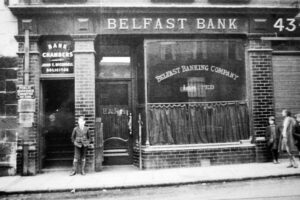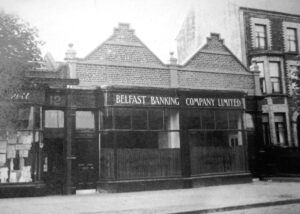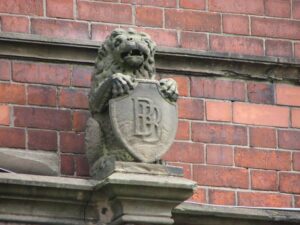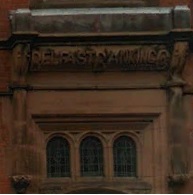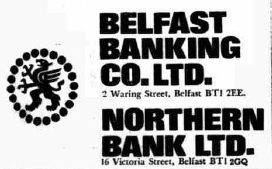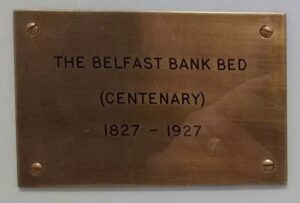Missing War Memorials in Ulster – Where are they?
History Hub Ulster researcher Nigel Henderson has identified the following war memorials as ‘missing or lost’ in Ulster.
History Hub Ulster has set up this Facebook page to maintain a record of these memorials.
Purple Star of Ulster LOL 1894
Installed in Clifton Street Orange Hall
Form: Tablet, Unveiled/Dedicated: August 1927, Newspaper image: Yes
Balmoral Methodist Church
Form: Tablet, Unveiled/Dedicated: January 1920, Newspaper image: Yes
College Square Presbyterian Church
Form: Organ & Tablet, Unveiled/Dedicated: November 1920, Newspaper image: No
Donegall Square Methodist Church
Form: Tablet, Unveiled/Dedicated: October 1921, Newspaper image: No
Donegall Square Methodist Church – Sunday School
Form: Tablet, Unveiled/Dedicated: July 1919, Newspaper image: No
Duncairn Mission Hall, New Lodge Road
Form: Clock, Unveiled/Dedicated: November 1919, Newspaper image: No
Falls Road Methodist Church
Form: Tablet, Unveiled/Dedicated: Not Known, Newspaper image: No
Mervue Street Mission Hall
Form: Reading Desk, Unveiled/Dedicated: September 1920, Newspaper image: Yes
Nelson Memorial Presbyterian Church
Form: Window, Unveiled/Dedicated: November 1946, Newspaper image: No
Presbyterian Ministers
Form: Tablet, Unveiled/Dedicated: June 1921, Newspaper image: No
St John’s Church of Ireland, Laganbank
Form: Window, Unveiled/Dedicated: July 1919, Newspaper image: Yes
“Our Boys Hall”, Manor Street
Form: Parchment Roll, Unveiled/Dedicated: May 1920, Newspaper image: Partial
Belfast Boy Scouts (10th Company) Cradle Roll
Form: Tablet, Unveiled/Dedicated: April 1919, Newspaper image: Yes
Belfast Boy Scouts (10th Company)
Form: Tablet, Unveiled/Dedicated: February 1927, Newspaper image: No
Belfast YMCA
Form: Window, Unveiled/Dedicated: September 1949, Newspaper image: No
Central Presbyterian Association (First World War)
Form: Tablet, Unveiled/Dedicated: November 1923, Newspaper image: No
Central Presbyterian Association (Second World War)
Form: Tablet, Unveiled/Dedicated: November 1949, Newspaper image: Yes
Cliftonville Cricket & Lawn Tennis
Form: Tablet, Unveiled/Dedicated: March 1927, Newspaper image: Yes
Londonderry Presbyterian Working Men’s Institute
Form: Tablet, Unveiled/Dedicated: July 1924, Newspaper image: No
Ulster Amateur Flute Band
Form: Tablet, Unveiled/Dedicated: February 1922, Newspaper image: Yes
Ulsterville Harriers
Form: Tablet, Unveiled/Dedicated: May 1918, Newspaper image: Yes
Belfast Co-Operative Society
Form: Tablet, Unveiled/Dedicated: November 1958, Newspaper image: No
Cinnamond, Park & Company
Form: Tablet, Unveiled/Dedicated: October 1920, Newspaper image: No
Dunville & Company Roll of Honour
Form: Parchment Roll, Unveiled/Dedicated: March 1921, Newspaper image: No
Gallaher’s Factory, Belfast
Form: Tablet, Unveiled/Dedicated: June 1948, Newspaper image: No
General Post Office (Royal Avenue, Belfast )
Form: Tablet, Unveiled/Dedicated: November 1925, Newspaper image: Partial
Glen Printing & Finishing Company (Newtownards)
Form: Parchment Roll, Unveiled/Dedicated: December 1917, Newspaper image: Yes
North East Bar
Form: Tablet, Unveiled/Dedicated: March 1920, Newspaper image: Yes
Bridgett, William Henry, Sergeant, Royal Irish Rifles
Form: RBP Banner, Unveiled/Dedicated: June 1923, Newspaper image: Yes
Jamison Brothers of Hydepark
Form: Tablet, Unveiled/Dedicated: August 1917, Newspaper image: No
McClean, Hugh, Farrier, Army Service Corps (Location not known)
Form: Statue, Unveiled/Dedicated: February 1927, Newspaper image: Yes
McMaster, Charles, Captain, Royal Irish Rifle (Location not known)
Form: JLOL Banner, Unveiled/Dedicated: October 1926, Newspaper image: Yes
Pollock, Paul Gilchrist, Lance-Corporal, Royal Irish Rifles
Form: Toc H Lamp, Unveiled/Dedicated: January 1933, Newspaper image: No
Antrim Road National School
Form: Window, Unveiled/Dedicated: September 1920, Newspaper image: No
Malone Training School
Form: Tablet, Unveiled/Dedicated: July 1920, Newspaper image: No
Albion Limited – First World War
Form: Parchment Roll of Honour
Albion Limited – Second World War
Form: Parchment Roll of Honour



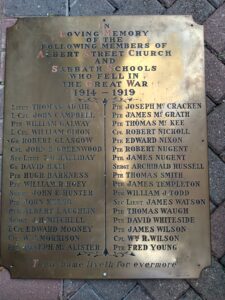 The local newspapers reported that “Rev. Montgomery said many of the men whose names were on the memorial plaque had been baptised by him. All of them had gallantly responded to the call of duty, and that was one of the noblest testimonies that could be offered to their patriotism as well as their Christianity. In that respect they were unlike the young men of England. Scotland, and Wales, who in the middle stages of the war were obliged to serve in His Majesty’s forces whether they liked to do so or not. The young men of that congregation, and of Ulster generally, answered the call from within when they knew the motherland was in peril, and indeed not they alone, but Ulstermen all over the world—in Canada, the United States of America, and Australia. The same blood flowed in all their hearts, and there was the same desire on the part of all to stand for their country and their Empire.” (Northern Whig, 3rd November 1919).
The local newspapers reported that “Rev. Montgomery said many of the men whose names were on the memorial plaque had been baptised by him. All of them had gallantly responded to the call of duty, and that was one of the noblest testimonies that could be offered to their patriotism as well as their Christianity. In that respect they were unlike the young men of England. Scotland, and Wales, who in the middle stages of the war were obliged to serve in His Majesty’s forces whether they liked to do so or not. The young men of that congregation, and of Ulster generally, answered the call from within when they knew the motherland was in peril, and indeed not they alone, but Ulstermen all over the world—in Canada, the United States of America, and Australia. The same blood flowed in all their hearts, and there was the same desire on the part of all to stand for their country and their Empire.” (Northern Whig, 3rd November 1919).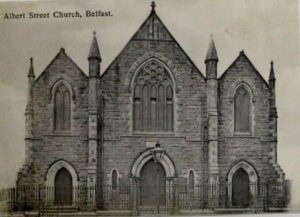 In 1970, due to demographic changes (partially due to the “troubles”) resulting in a fall in the size of the congregation, and the redevelopment plans for the Lower Falls area, the decision was taken to merge with the nearby congregation at Argyll Place Presbyterian Church on the Shankill Road. The final services in the Albert Street church were held on Sunday 31st January 1971 and led by the Reverend Brian Moore. On 7th February 1971, the first services were held in the Shankill Road premises of the newly named West Kirk Presbyterian Church. When the congregation moved, the war memorial plaque was not transferred to West Kirk.
In 1970, due to demographic changes (partially due to the “troubles”) resulting in a fall in the size of the congregation, and the redevelopment plans for the Lower Falls area, the decision was taken to merge with the nearby congregation at Argyll Place Presbyterian Church on the Shankill Road. The final services in the Albert Street church were held on Sunday 31st January 1971 and led by the Reverend Brian Moore. On 7th February 1971, the first services were held in the Shankill Road premises of the newly named West Kirk Presbyterian Church. When the congregation moved, the war memorial plaque was not transferred to West Kirk.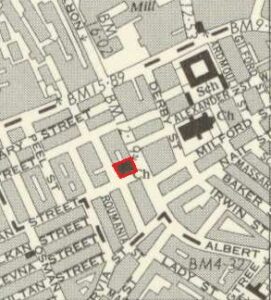 Five sons of William Nugent and Sarah Nugent (nee McFerran) of Percy Street enlisted for military service in the Great War. Three were to survive but two lost their lives and are commemorated on this memorial plaque.
Five sons of William Nugent and Sarah Nugent (nee McFerran) of Percy Street enlisted for military service in the Great War. Three were to survive but two lost their lives and are commemorated on this memorial plaque.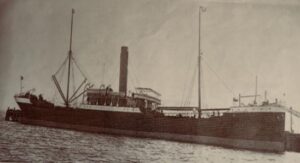 Guest author Jim has sent us in an article The Ordeal of the Bray Head about the sinking of the SS Bray Head in 1917.
Guest author Jim has sent us in an article The Ordeal of the Bray Head about the sinking of the SS Bray Head in 1917.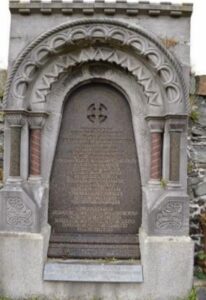 Guest author Ruth Allister has provided us an extensive history of the imposing McLean monument in the Priory Graveyard, Holywood.
Guest author Ruth Allister has provided us an extensive history of the imposing McLean monument in the Priory Graveyard, Holywood.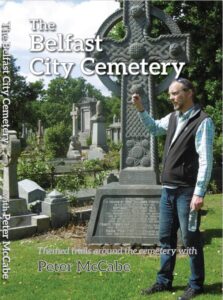
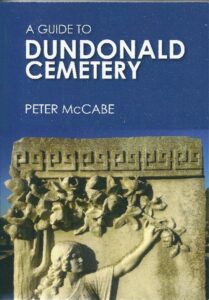
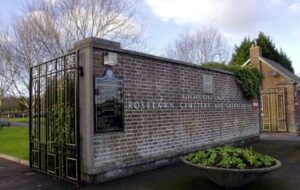 Trail 1 is the Quirky Trail, and the headstone I’ve selected for this is William Johnston, ‘a musician, an Elvis impressionist (Billy Fonda). Bill grew up on Donegall Road, The Village, Belfast. Laid to rest 17th December 2004’, with the Quirky trail also featuring Elmekki Berrabah ‘“Kebab Man” Returned To Allah On 12th April 2015’, and he is buried in the small Muslim section of the Cemetery.
Trail 1 is the Quirky Trail, and the headstone I’ve selected for this is William Johnston, ‘a musician, an Elvis impressionist (Billy Fonda). Bill grew up on Donegall Road, The Village, Belfast. Laid to rest 17th December 2004’, with the Quirky trail also featuring Elmekki Berrabah ‘“Kebab Man” Returned To Allah On 12th April 2015’, and he is buried in the small Muslim section of the Cemetery.